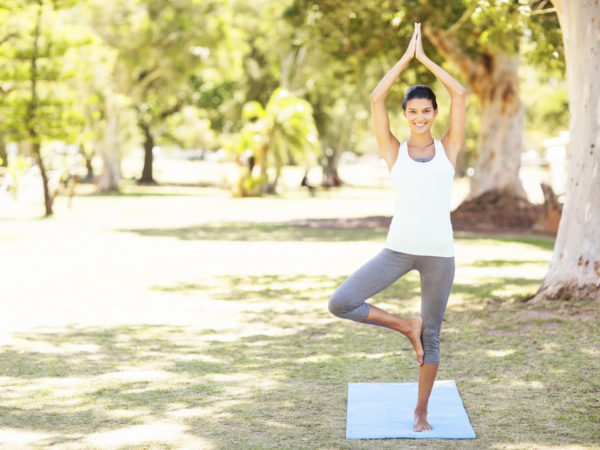Tree Pose

“One of my favorite yoga poses, the Tree Pose is a great way to promote relaxation. I imagine myself as a tall, deeply rooted desert cottonwood while performing this pose.” – Andrew Weil, M.D.
Description & History
The Tree Pose, known as Vrksasana in Sanskrit, is a basic yoga pose used to promote balance and centering. The Sanskrit name comes from the words vrksa meaning tree, and asana meaning pose. The Tree Pose strengthens and tones the leg muscles, ankles and feet as well as the groin, inner thigh. It opens up the muscles of chest and shoulders as well as stabilizing core musculature, especially of the hips and spine.
How to Perform Tree Pose
- Start in Tadasana, or standing position with your legs shoulder-width apart and arms at your side.
- Shift your weight to the left foot and bend your right knee bringing it off the floor slightly. Reach down with your right hand and grasp your right ankle.
- Bring your right foot up and place the sole against the inner thigh of your left leg with the heel as close to the groin as possible, avoiding the knee with toes pointing to the floor. Turn the right knee outward to open the right hip.
- Rest your hands on the top of your pelvis and make sure it is parallel with the floor, left hip directly over your left foot to aid with balance. Firmly press the sole of the right foot against the inner thigh, while resisting with the outer aspect of the left leg.
- When balanced, bring your hands together in front of your chest in Anjali Mudra and focus on a fixed point on the floor about five feet in front of you.
- You can also bring hands above your shoulders, opening up the rib cage and placing them in a V-position.
- Stay in the pose for 30 seconds to one minute. When ready, exhale and bring the right foot to the floor. Repeat the Tree Pose, but this time with the opposite foot.
Potential Health Benefits
- Strengthens buttocks, thighs, calves and ankles, spine
- Stretches groin and inner thigh, chest and shoulders
- Improves balance
- Relieves sciatica
- Calms and relieves stress
Studies show the practice of Tree Pose has positive benefits on overall balance and coordination. One 2012 study published in the journal Evidence-Based Complementary and Alternative Medicine looked at the health benefits of the Tree Pose in seniors. The study concluded that even though the Tree Pose is considered a simple pose, it places demands on the body that can lead to improved strength and balance. These may then help reduce the number of falls in seniors
Modifications & Variations
Beginners may have difficulty maintaining balance during the Tree Pose. One way to help maintain balance is to stand next to a wall or chair and use one of those options as a way of practicing the pose. Once you are comfortable with standing on one foot, you can slowly increase the time you stand without bracing against the wall or chair.
If you experience limited flexibility in your legs when placing your foot on the inside of your thigh, you can instead place your foot on your lower leg or calf, depending on your flexibility. Remember to keep the knee turned out to increase the stretching of your groin.
If you are an advanced practitioner, enter the Tree Pose and bring your hands together in front of your chest into Anjali Mudra. After you are balanced, clasp your hands together but keep your index fingers pointed up. Lift your hands and arms straight up above your head and maintain this pose. Another advanced modification of the Tree Pose is to close your eyes. Learning to balance while not being able to see can be difficult, but it will help you visualize your body grounded to earth.
Precautions
If you have a history of low blood pressure or high blood pressure, do not raise your arms above your head – doing so can negatively affect blood pressure. Instead, only raise arms and place palms together in front of the chest in Anjali Mudra. Also, use caution if you have knee pain. Using a solid surface such as a chair or wall can help with balance and reduce the risk of injury.
Related Poses
- Mountain Pose (Tadasana)
- Upward Salute (Urdhva Hastasana)
- Chair Pose (Utkatasana)
- Eagle Pose (Garudasana)
- Extended Hand-to-Toe Pose (Utthita Hasta Padangustasana)
Reviewed by: James Nicolai, M.D., on May 21, 2013
Sources
Yu, Sean S-Y., Man-Ying Wang, Sachithra Samarawickrame, Rami Hashish, Leslie Kazadi, Gail A. Greendale, and George J. Salem. “The Physical Demands of the Tree (Vriksasana) and One-Leg Balance (Utthita Hasta Padangusthasana) Poses Performed by Seniors: A Biomechanical Examination.” Evidence-Based Complementary and Alternative Medicine 2012 (2012).









